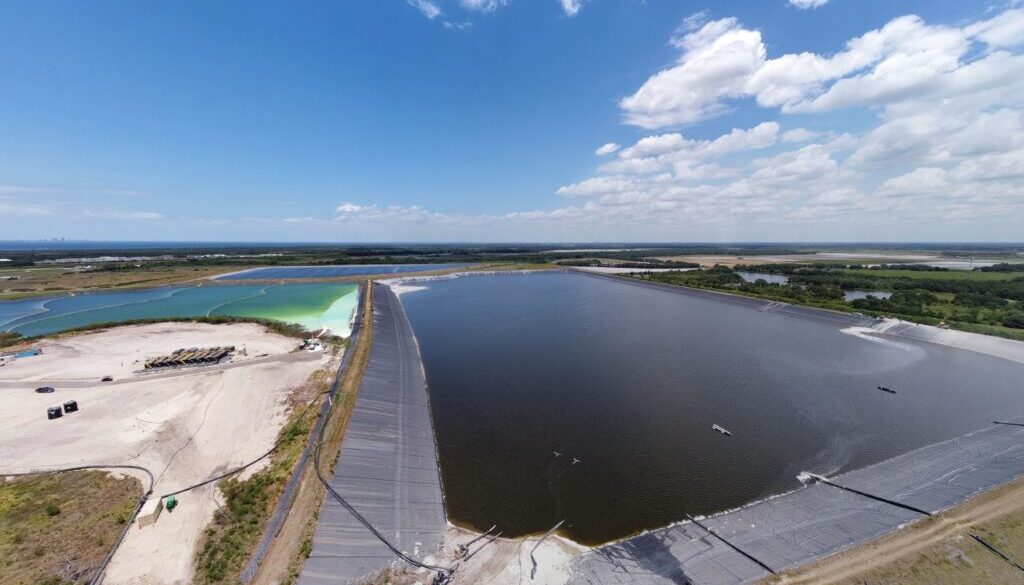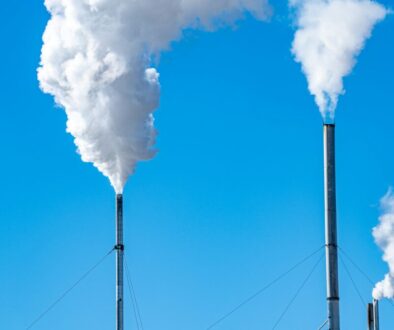In Hurricane Milton’s wake, toxic “gypstacks” threaten Tampa Bay area
As southwest Florida reels from the impact of Hurricane Milton this week, the first hurricane to directly hit the Tampa Bay area in a century, environmentalists are bracing for another possible impact – the contamination of local waterways from towering stacks of toxic industrial waste in the storm’s path.
When phosphate is processed into fertilizers for farmland, enormous quantities of phosphogypsum are left behind as heaps of concrete-like waste called “gypstacks,” which are topped with liquid waste ponds. Most US phosphate production takes place in Florida, with 25 of the 30 gypstacks located in the Sunshine State – a quantity totaling over a billion tons. The waste contains heavy metals as well as radium, which decays into a radioactive gas that causes lung cancer, according to the US Environmental Protection Agency (EPA).
“We refer to [the stacks] as ‘Florida’s Mountains’,” said Ragan Whitlock, staff attorney for the environmental nonprofit the Center for Biological Diversity, noting that the heaps of toxic chemical waste are each hundreds of feet wide and hundreds of feet tall. “Lesser storms than hurricanes have created massive structural integrity problems at these stack systems,” he said.
Of Florida’s 25 gypstacks, 22 were “at least generally in Hurricane Milton’s track,” said Whitlock, with three located directly near the bay. Whitlock said he is worried about pollution from the stacks impacting both the bay and the Floridan aquifer, which almost 10 million people depend on for drinking water.
The largest US producer of phosphate fertilizer, The Mosaic Company, revealed in an email Friday that it believes stormwater at its Riverview site, where it stores toxic phosphogypsum waste from fertilizer production, made its way into Tampa Bay after a water collection system onsite became overwhelmed following the hurricane.
“At this time, we believe some of that impacted stormwater made its way to an outfall which discharges into Tampa Bay,” said the Mosaic spokesperson. “The issue was addressed yesterday and is not continuing. The volume may have been greater than the 17,500 gallon reporting standard. We expect water quality impacts, if any, to be modest.”
Mosaic said in a September 30 statement that early assessments showed “limited damage” to its facilities following Hurricane Helene, a Category 4 storm that hit Florida on September 27, although its Riverview facility “experienced water intrusion caused by the storm surge.” In an early June statement, Mosaic said it was “prepped and ready” for hurricane season.
Mosaic said in its email that regulators were onsite Friday.
“It is saddening to hear that pollution has once again entered Tampa Bay from a phosphate waste facility,” said Whitlock. “This is yet another setback to the recovery of our beloved bay. We must do better to protect the environment from toxic waste.”
Not much can be done to prepare phosphogypsum waste stacks for the impact of hurricanes, said Whitlock, because “the facilities are just open-air pits of hazardous waste.”
“There just simply is no good way to store this stuff,” he said. “It creates problems for decades.”
Last month, a federal judge found the previous owner of Florida’s Piney Point facility guilty of discharging 215 million gallons of contaminated wastewater into Tampa Bay in 2021, triggering a toxic algae bloom that killed over 600 tons of marine organisms.
No damage was reported at Piney Point from Hurricane Debby in August, when the site received over nine inches of rain.
Justin Tramble, the executive director of Tampa Bay Waterkeeper, a nonprofit focused on clean water in the Tampa Bay area, said in an email Friday that his organization is still evaluating impacts from the area’s phosphogypsum stacks following Hurricane Milton. Heavy rains from the storm pose a “significant risk” of contamination from the stacks, he said, jeopardizing both human health and the environment.
The Florida Department of Environmental Protection, which oversees the state’s phosphogypsum stacks, did not reply to request for comment.
In addition to risks of phosphogypsum pollution, the Tampa Bay area faces dangers if flooding from Hurricane Milton impacts local power plants with coal ash ponds, which can release toxic substances such as arsenic and lead into drinking water if they overflow, as well as Superfund sites, according to a statement from the Environment America Research & Policy Center.
The city of Asheville, North Carolina, which was devastated by Hurricane Helene just weeks earlier, is “not able to confirm the extent to which pollution or chemical issues from Helene have affected our area,” said a spokesperson for the Asheville Fire Department.
“Several agencies are currently evaluating the situation, but I do not have any results to share just yet,” said the spokesperson. “The Asheville Fire Department’s Hazardous Materials team is actively out each day, locating and addressing these issues to ensure our safety.”
A 2021 study concluded that “accidental industrial releases are becoming of greater concern with the increase in extreme weather events due to climate change,” noting that Hurricane Florence in 2018 triggered coal ash releases and flooded waste lagoons at concentrated animal feeding operations (CAFOs), while Hurricanes Irma and Maria in 2017 lead to elevated air pollution, among other impacts.
Last March, the EPA finalized new safeguards that will require industrial facilities to evaluate risks of accidental chemical releases and plan responses.
“As climate change increases the frequency and severity of extreme weather events, planning and preparedness for these incidents are especially important,” said Clifford Villa, the EPA Deputy Assistant Administrator for the Office of Land and Emergency Management.
(Featured image: South side of the Piney Point gypstack. Photo by Center for Biological Diversity.)
 EWG
EWG


